Ellis,J. Pressure transients in water engineering, A guide to analysis and interpretation of behaviour
Подождите немного. Документ загружается.

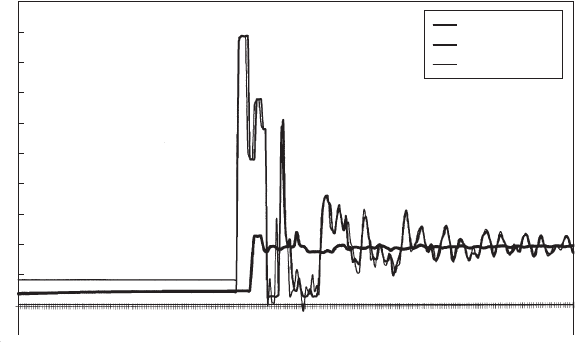
As in all aspects of pressure transient control where air valves are
involved, the remedy is often to control the differential velocity
which exists at the air valve connection just as the valve is about to
close. This requires some regulation of air outflow rate through the
valve or alternatively avoiding the abrupt union of water columns.
Possible means of avoiding an unacceptable shock rise in pressure
include the following.
18.1.1 A more restricted air outflow device
Using an air valve having more limited air outflow capacity will produce
a pressure rise in the air-filled riser, leading to compression of the air
mass. The pump operating at design speed will experience a greater
delivery pressure, causing it to operate at higher head and lower flow
rate than with the earlier large-orifice valve. With the lower flow rate
and velocity V
u=s
, the shock pressure rise H following air valve closure
and given by equation (18.1), will also be lower, although H
u=s
will be
increased to some extent.
There is a limitation on the extent to which the air valve outflow may
be throttled. If the venting rate is restricted to a large extent, head in
the air pocket below the valve may exceed the piezometric level down-
stream of the check valve, causing the valve to open slightly and air to
escape into the downstream system. Depending upon the configuration
of the check valve, some of this air may collect in the upper part of the
332
Delivery
AV connection
d/s NRV
Head (mAOD)
Time (s)
AYR solo pump op/1 s start
200
180
160
140
120
100
80
60
40
20
0
–20
8.297
8.326
8.356
8.386
8.416
8.446
8.476
8.506
8.536
8.566
8.595
8.625
8.655
8.685
8.715
8.745
8.775
8.805
8.835
8.864
8.894
8.924
8.954
8.984
9.014
9.044
9.074
9.103
Fig. 18.8. Head in the riser during/following riser filling (detail)
Pressure transients in water engineering
valve body downstream of the door. When the valve is later opened
fully after the air valve shuts, the door will travel into a region partially
filled with air. Damping of the door motion can be reduced by this air
pocket, allowing the door to open more rapidly and causing it to
violently strike its stop, possibly resulting in damage.
18.1.2 Soft-start of the pump
The pump may be operated in such a manner that it does not attain its
maximum speed until after all air has been vented through the large-
orifice air valve. Pump speed may be gradually ‘ramped’ so that from
moment to moment the H—Q curve alters (Fig. 18.4). Pump speed
remains at a rate sufficiently low that excessive velocity V
u=s
does not
develop. Where H
s
is the ‘shut valve’ head at the pump at design
speed N
s
, if the elevation difference between the liquid surface in the
wet well and the air valve is Z then a pump speed N given by:
H
s
=N
2
s
¼ Z=N
2
or N ¼ N
s
p
ðZ=H
s
Þð18:2Þ
will be just sufficient to fill the riser and hold the liquid column in place.
A marginally higher speed will ensure a quiet air valve closure but
without opening the check valve.
Computations can be undertaken to establish the relationship
between ‘ramp slope’ dN=dt and pressure rise on air valve closure. In
this case the pump motor is capable of a maximum ramp time of
4 min and Fig. 18.9 shows predicted peak transient head at the pump
delivery, at the riser air valve connection, at the elevated air valve
and at the start of the rising main as functions of the time for the
pump to reach its design speed. A very short ramp time will not be
beneficial as it will allow the pump to achieve its maximum speed
before air valve closure and thus velocity V
u=s
will also be at or close
to the maximum for the low operating head. In this case, ramp times
of 18 s or less are therefore of no benefit.
By extending the time taken for a pump to achieve design speed
till a point beyond the air valve closure time, then the velocities in
the riser can be limited and the corresponding shock pressure rise
when the valve shuts is reduced. In this instance a ramp time of
around 1 min would reduce maximum head to around one-third of
the maximum.
A two-speed motor could be used with the lower speed maintained
until riser filling has been completed without undue pressure rise.
Thereafter the pump speed can be increased to the higher speed.
333
Air and gas
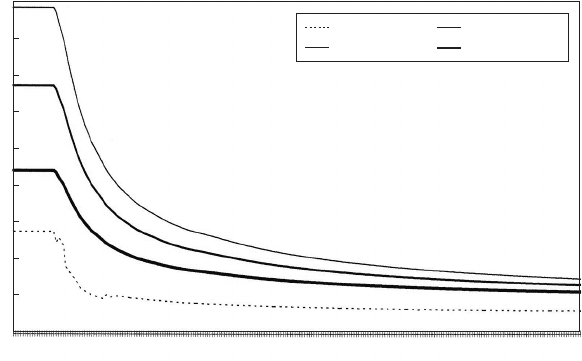
18.1.3 Use of an accumulator
An alternative surge suppression device which may be found on
borehole riser pipes is a bladder accumulator of the type illustrated in
Fig. 13.2b. The pump is started without any restriction on speed rise
and a large-orifice air valve may be included just upstream of the
check valve on the well head. The shock pressure rise, developed
when the air valve closes, travels as a compression wave to the accumu-
lator from which it is reflected as a rarefaction wave and producing rapid
pressure relief. A compression wave also travels downstream from the
air valve, causing a pressure rise which is very short-lived as it is quickly
followed by the rarefaction wave from the accumulator. Prevention of a
shock pressure increase is considered to be better than curing such a
pressure rise after it has developed. The accumulator offers a remedy
if unacceptable pressures are found during commissioning of a scheme
when other remedies are no longer viable.
18.2 Pump start with slow valve clos ure
Where a direct pump start is used then a further option to restrict shock
pressure rise may be to use a slow-closing air-venting valve. Consider
the situation illustrated in Fig. 18.10. A two-stage borehole pump,
Weir Pumps Ltd type SBWM 600, is intended to lift water abstracted
334
Delivery AV connection
Elevation AV Rising main
Maximum head (mAOD)
Time to reach desi
g
n speed (s)
AYR solo pump op/ramp rate results
0
9
18
27
36
45
54
63
72
81
90
99
108
117
126
135
144
153
162
171
180
189
198
207
216
225
234
180
160
140
120
100
80
60
40
20
0
Fig. 18.9. Maximum head during riser filling plotted against ramp slope
Pressure transients in water engineering
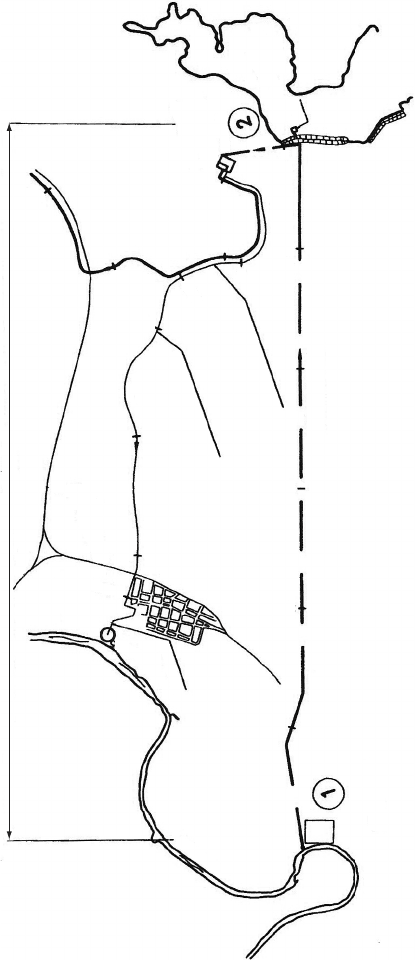
335
Modulo 1
Crucero Clarines
Estanque
Clarines
Clarines
Rio Unare
Aduccion
El Yai
Toma
Embalse
Santa Clara
Alimentacion
Clarines
Santa Clara
Planta de
Tratamento
6 + 476
0
1
2
3
4
5
6
1
0
1
2
3
2
1 + 510
4
+
360
4 + 875
3
4
∆
10" Acero
L = 2840 m
∆
12" Acero
L = 1510 m
∆
10" P.V.C.
∆20"
Fig. 18.10. El Yai water transmission system
Air and gas
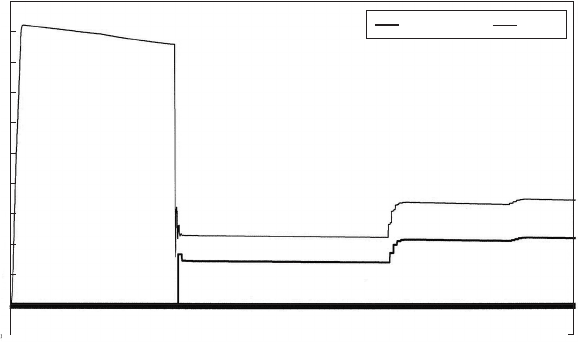
from Rio Unare and to transfer this water at a rate of 350 litres/s either
to Santa Clara storage reservoir or directly to the nearby Santa Clara
treatment works. Pressure rating of the existing 20 in (508 mm) steel
rising main is 16 bar(g) and the pump duty head is 110 m.
18.2.1 Air venting through a standard air valve
Direct start of the pump produces a peak velocity of 4.58 m/s in the
initially air-filled riser (Fig. 18.11). Air is vented at a high rate through
an air valve sited in the horizontal section of pipeline downstream of the
908 bend at the top of the riser (Fig. 18.12). Closure of the air valve
on completion of venting produces a shock pressure rise beyond the
allowable maximum transient pipeline pressure (Fig. 18.13).
18.2.2 A butterfly valve for air venting
Installing a small butterfly valve in place of the air valve allows a quieter
start-up to be achieved. When the pump is operated, air is expelled via
the open butterfly valve connected to a backwash pipe leading back to
the suction well (Fig. 18.14). When all air has been removed, water
starts to flow through the butterfly valve back to the wet well. Due
to the greatly increased flow resistance, as liquid rather than air now
flows through the butterfly valve and backwash line, and there is a
336
0.003
0.325
0.647
0.968
1.290
1.611
1.933
2.255
2.576
2.898
3.220
3.541
3.863
4.184
4.506
4.828
5.149
5.471
5.793
6.114
6.436
6.758
7.079
7.401
7.723
8.044
8.366
8.688
9.009
9.331
9.652
Time
(
s
)
El Yai/duty pump start/velocities
Velocity (m/s)
5
4.5
4
3.5
3
2.5
2
1.5
1
0.5
0
–0.5
Ch. –0 km Riser
Fig. 18.11. Velocity at pumping station after pump start
Pressure transients in water engineering
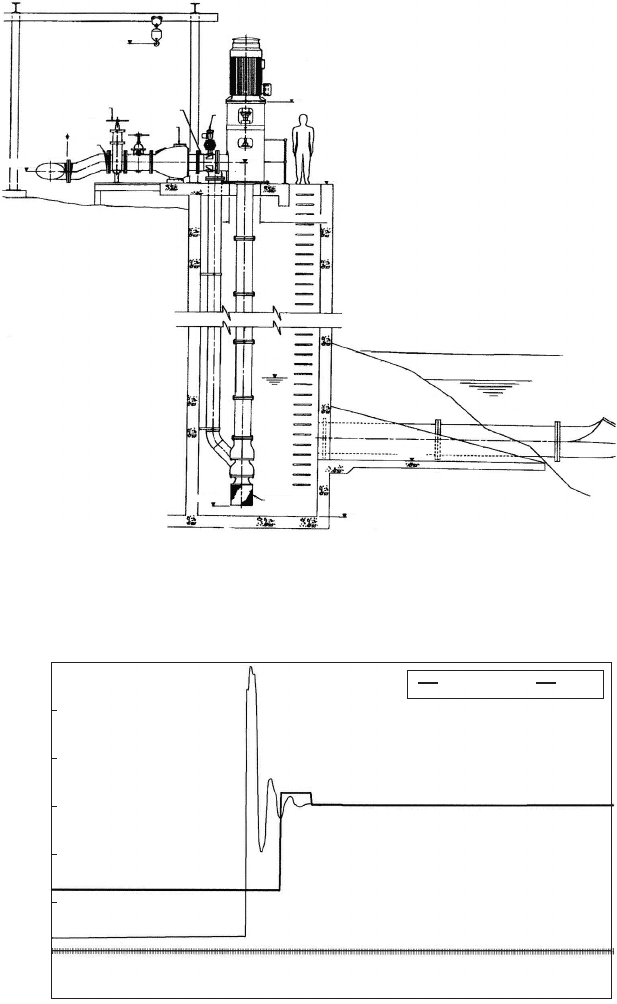
337
10.670 m
3 tonne manual hoist
TPI
SW
400 on
6V
400 on TFA
AV
6.995 m
770 SD
floor opening
6.470 m
8.510 m
min W.L.
0.000 m
Strainer
–3.164 m
6.760 m
–3.430 m
–2.030 m
Inlet pipe
(by others)
400 on
RCV
Fig. 18.12. Elevation through pumping station
2.5
2.540
2.580
2.619
2.659
2.699
2.739
2.779
2.818
2.858
2.898
2.938
2.978
3.017
3.057
3.097
3.137
3.176
3.216
3.256
3.296
3.336
3.375
3.415
3.455
3.495
3.535
3.574
3.614
Time
(
s
)
El Yai/duty pump start
Head (mAD)
300
250
200
150
100
50
0
–50
Ch. 0.0 km Riser
Fig. 18.13. Head at pumpin g station after pump start (detail)
Air and gas
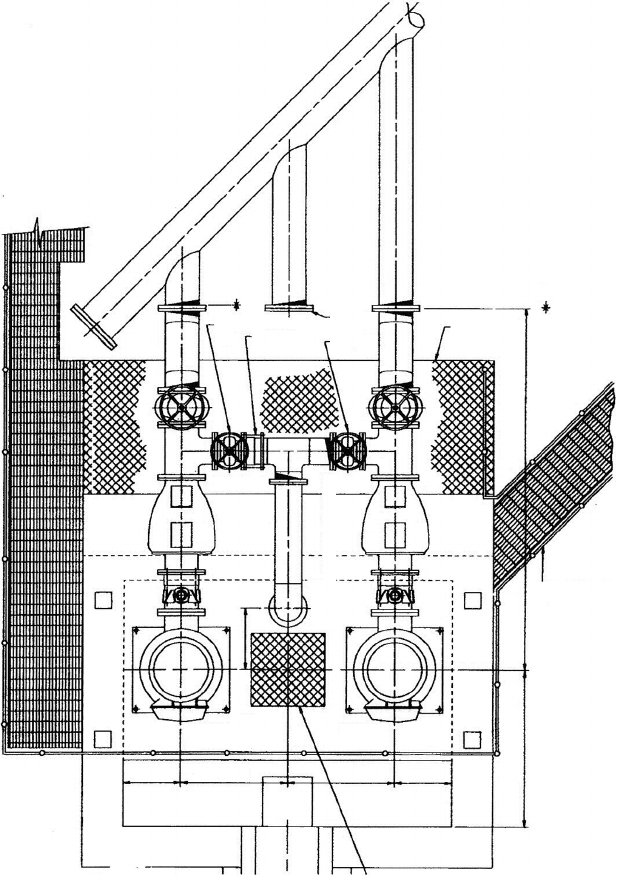
shock rise in pressure at the butterfly valve connection (Fig. 18.15).
Sizing the butterfly valve appropriately allows the peak transient
pressure at this connection to be limited. Once this initial upsurge
has dissipated, the butterfly valve can be closed gradually. The shock
338
Existing 500 DN delivery main
TP1 TP2
New access
walkway
Existing
platform
4400 Approx.
Pumpset
No. 2
Pumpset
No. 1
700 700
750
1900
300 DN
Back flushing pipework
1300 1300
300 DN
GV
300 DN
TFA
400 DN
BF
300 DN
GV
Fig. 18.14. Plan showing pipework and valves
Pressure transients in water engineering

pressure rise forces the non-return valve open and flow is established in
the downstream rising main.
Following a pump trip, as piezometric level falls, the butterfly valve
automatically reopens allowing air to re-enter the riser.
18.3 Air venting through a ‘sparg’ line
Another means whereby an air-filled riser may be primed after pump
start and without the development of an excessive shock pressure rise
as the riser becomes filled is through the introduction of a ‘sparg’
line. This may take the form of a pipeline connected at the same
position as an air valve, leading back to the wet well. As the riser fills
with liquid, air passes through the sparg line to be released into the
wet well. After filling, the line then returns a relatively small proportion
of the liquid flow to the wet well. The sparg line has to be of sufficient
size that it reduces inertial pressure to an acceptable extent without
having an excessive effect on the efficiency of pumping. In the case
of sewage pumping, the sparg line may be at risk of blocking.
18.4 Gas evolution
If no air valve is placed before the check valve in a sewage system or if
an air valve becomes blocked for example, problems may still arise.
339
Time
(
s
)
El Yai/duty start
Head (mAD)
250
200
150
100
50
0
–50
Ch. 0.0 km Riser AV
2.5
2.669
2.838
3.007
3.176
3.346
3.515
3.684
3.853
4.022
4.191
4.360
4.529
4.698
4.868
5.037
5.206
5.375
5.544
5.713
5.882
6.051
6.220
6.390
6.559
6.728
6.897
7.066
7.235
7.404
7.573
Fig. 18.15. Head after pump start (detail)
Air and gas
While the liquid column is static, gas may evolve from the column of
sewage upstream of the check valve both under septic conditions and
also because the column is under vacuum pressure. When the pump
is started and flow commences in the riser, the gas volume is
compressed. As pressure within this volume rises to match the piezo-
metric head downstream of the check valve, gas will be pushed into
the downstream line through this valve. When all gas has been removed
from upstream of the non-return valve then the column of liquid will
impact against the valve door, throwing it open violently into the
downstream fluid which is a mixture of sewage and gas. Damage to
valve doors and stops has occurred as a consequence.
18.5 Gas pockets in a pipeline
A risk may exist in pipelines generally when a pocket of air or gas is
present under transient conditions. This potential problem was
indicated by Martin (1976) with regard to the expulsion of air through
a valve while filling a pipeline using a pump. In a recently released
design manual edited by Escarameia (2005), studies of air pocket
influence on hydraulic transients indicated a possible amplification of
maximum pressures. Any amplification is strongly dependent upon
the configuration of the particular pipeline being studied but ampli-
fication was predicted by a factor of up to 260% over the equivalent
pressures without the presence of air pockets. Field observations of
Danish uPVC pipelines also showed amplification. The dependency
of peak pressure on air pocket volume was also established.
The basic problem can easily be illustrated by considering transient
behaviour in a simple pipeline containing a trapped mass of air or gas
at its upstream limit (Fig. 18.16). Supposing that the liquid-filled
sloping pipeline has previously been subject to an hydraulic transient
event, say a pumping failure, which has produced a low pressure say
8.0 mWG at the upstream end of the line. Suppose that a volume
of gas has evolved from solution during the low pressure produced by
this initial transient event. For simplicity the gas was not reabsorbed
into the liquid by the influence of rising pressure.
Under action of the adverse transient, hydraulic gradient flow will
develop from the downstream reservoir towards the gas pocket. The
strength of this reversed flow and its duration will depend upon the
ability of the system to accommodate this flow.
With no gas volume present, the only storage available within the pipe-
line is that resulting from extension of the pipe wall and from compression
340
Pressure transients in water engineering
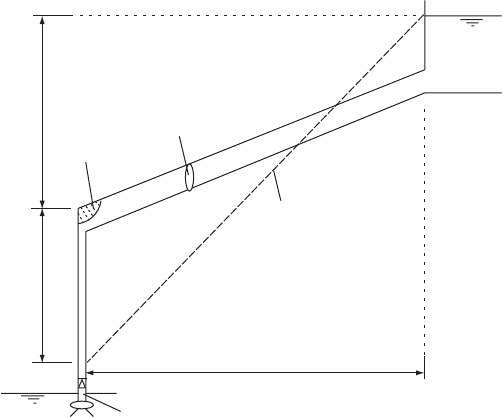
of the liquid component. The amount of reversed flow and its duration are
modest in these circumstances. A short duration of reversed flow allows
only a modest time for flow acceleration to occur, resulting in a relatively
small reversed velocity. Inertial head rise is a function of this maximum
reversed velocity and so the peak pressure will also be relatively modest.
When a volume of gas is present, an additional storage component
exists, namely the volume available as the gas mass is compressed by
the increasing pressure produced by the reversed flow. This component
can be written by differentiating equation (12.2) as:
dVol=dp
abs
¼1=nVol=p
abs
ð18:3Þ
Allowing reversed flow to develop, the gas volume is compressed with
rising pressure. The hydraulic gradient flattens and the acceleration
towards the gas pocket reduces and finally ceases as a positive gradient
is established. The peak pressure within the gas pocket will depend on
the maximum reversed velocity and the initial volume of gas present.
The duration of reversed flow and the maximum reversed velocity
will increase as the initial volume of gas is increased. Deceleration of
this reversed velocity will occur when the combined effects of rising
pressure in the gas pocket plus developing pipeline resistance produce
a positive hydraulic gradient within the pipeline. Even a relatively
341
Pump and NRV
1000 m
Riser
Hydraulic gradient at
time of flow reversal
10 m
8 m
Gas pocket
DN 300
M
M
Fig. 18.16. Simple system with air pocket
Air and gas
